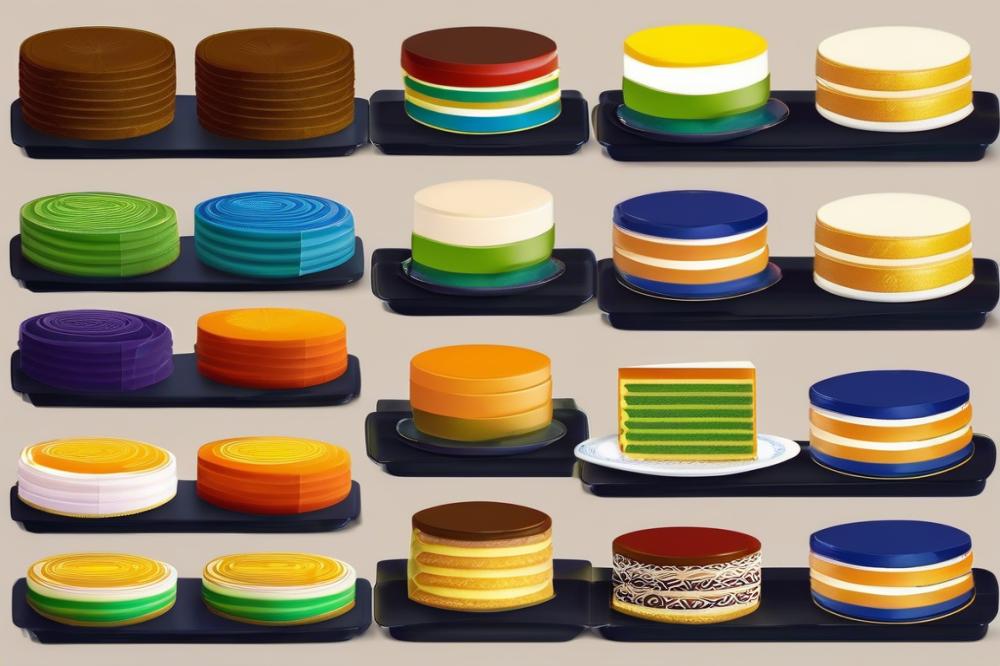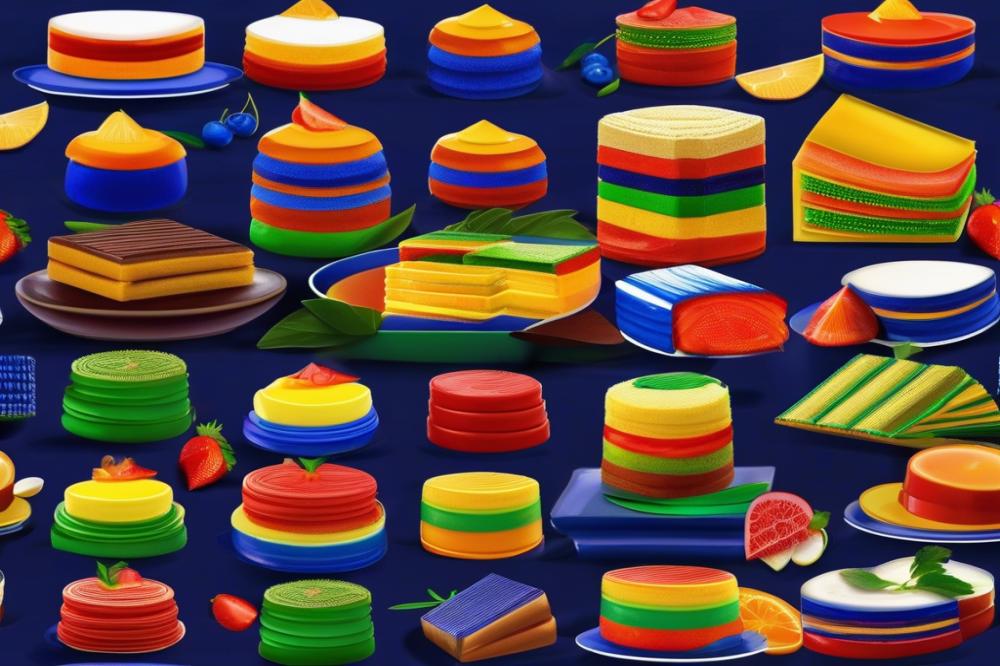Introduction
recipebix.com/gulai-ayam-recipe-malaysian-chicken-curry-with-coconut-milk”>Kuih Lapis is a delightful traditional Malaysian dessert that has captured the hearts of many. Known for its vibrant colors, this steamed cake features layers that are both appealing and delicious. The recipe involves the rich use of coconut milk, which adds a creamy texture, while pandan leaves provide a hint of fragrance and color.
Celebrations and festive occasions often spotlight this cake. Its presence during gatherings and holiday festivities reflects the importance of desserts within Malaysian cuisine. Families and friends come together to enjoy its unique presentation and flavors, making it a favorite at every celebration.
The layers of Kuih Lapis are a visual treat, showcasing an array of hues that invite all to indulge. Each bite reveals the soft, chewy texture that sets it apart from other desserts. Appreciation for this Malaysian Layered Cake goes beyond taste; it encompasses tradition and cultural pride as well.
What is Kuih Lapis

Kuih Lapis is a delightful steamed cake that showcases the beauty of Malaysian desserts. Its colorful layers create a visual feast that appeals to both the eyes and the palate. Each slice reveals vibrant stripes, a hallmark of this traditional treat.
Originating from the rich cultural tapestry of Malaysia, this dessert has deep roots in local food traditions. It reflects the influence of various ethnic groups, making it a symbol of unity in Malaysia’s diverse culinary landscape. Families often prepare Kuih Lapis during festivals and special celebrations, making it a cherished part of their heritage.
Coconut milk plays a central role in the recipe, adding a creamy richness that enhances flavor. This ingredient is essential for creating the dessert’s unique texture. Likewise, pandan leaves are used for their aromatic qualities, providing a hint of sweetness and a lovely green hue. Together, these ingredients contribute to a sensory experience that defines the dish.
Ingredients and Cooking Instructions

List of Ingredients with Quantities
- 2 cups rice flour
- 1 cup coconut milk
- 1 cup sugar
- 2 cups water
- 1/2 teaspoon salt
- Pandan leaves for flavor and green coloring
- Food coloring for various layers
Step-by-Step Cooking Instructions
Start by preparing pandan juice. Blend pandan leaves with water, then strain the mixture through a fine sieve. This juice gives a vibrant color and a delightful flavor.
Next, combine rice flour, sugar, and salt in a large mixing bowl. Stir them well to create a homogenous dry mixture. This forms the base of your dessert.
After that, gradually add in the coconut milk along with the pandan juice. Mix until everything integrates smoothly. You want a batter that is lump-free.
Now, it’s time to color. Separate your mixture into different bowls based on how many colors you wish to use. Add food coloring to each bowl. This step allows you to create a visually appealing steamed cake.
Begin steaming. Pour the first colored layer into a greased cake pan. Steam it for about 10 to 15 minutes, until set. Once the first layer is done, pour in the next color on top. Repeat this process for each layer. Aim to achieve a colorful presentation.
Allow the finished cake to cool down completely before slicing. The layers should be distinct and festively colorful. Serve your kuih lapis as a treat during special occasions or simply enjoy it as part of your regular meal.
Nutritional Information

The Kuih Lapis is not only a colorful treat but also has varied nutritional components. Each ingredient contributes to its overall health profile. Let’s break down the nutritional values for each key element.
Rice Flour
This gluten-free flour serves as a primary carbohydrate source in the recipe. It provides energy without the wheat gluten found in traditional flours. For those with gluten sensitivities or celiac disease, it’s a fantastic choice.
Coconut Milk
Coconut milk adds creamy richness and is higher in calories than many other liquids. The healthy fats it contains can be quite beneficial, offering energy and a satisfying texture. In moderation, it enhances both flavor and nutritional quality.
Sugar
Sugar plays a significant role in this dessert as an energy source. While it sweetens the layers beautifully, it is vital to use it mindfully. Overconsumption can lead to health issues, so keeping portion sizes in check is important.
Pandan
This aromatic plant provides not only a lovely green color but also comes packed with antioxidants. Its unique flavor is a staple in Malaysian cuisine, elevating the dish while contributing to health benefits.
Discussion on Servings
Considering a typical serving size plays a crucial role in the nutritional content of the steamed cake. When enjoyed during festive occasions or gatherings, the enjoyment comes not just from taste but also from sharing. Each layer offers its individual flavor, making it a delightful experience. Portioning appropriately allows for guilt-free indulging while still enjoying the delicious layers of this traditional dessert.
Cultural Significance of Kuih Lapis
This delightful steamed cake holds an important place in Malaysian culture. Often served during celebrations, it brings color to festive gatherings. Families prepare this layered dessert for special occasions, such as weddings, festivals, and religious events. The preparation of this recipe is a cherished tradition passed down through generations.
Regions throughout Malaysia offer their own takes on this dish. In certain areas, you might find variations that include flavors such as sweet corn or chocolate. Others may use different ingredients, like yam or berries, adding a personal touch. Such adaptations showcase the creativity of community cooks and their willingness to experiment with local tastes.
In modern Malaysian cuisine, this dessert continues to thrive. Desiring a taste of nostalgia, people enjoy kuih lapis not just during celebrations but in everyday life as well. Its colorful layers of pandan and coconut milk capture attention and evoke fond memories. Young chefs and home cooks are rediscovering this traditional treat, blending old techniques with new ideas.
Tips for Making Perfect Kuih Lapis
Getting the steaming technique right is crucial for layered cakes. The steam should be consistent and gentle. Using a steamer basket lined with parchment paper can help prevent sticking. Ensure the water is boiling before placing the batter inside. This process helps imitate traditional cooking methods, keeping the cake moist.
Vibrant colors in your dessert not only make it attractive but also reflect the flavors inside. To achieve this, use natural ingredients like pandan leaves for a rich green shade. Mixing in different food colors can create eye-catching layers. Pour the batter slowly and steadily into the mold. This technique will help form even layers, giving the final result a neat look.
Presentation plays a vital role in Malaysian cuisine. Once the steamed cake cools, consider cutting it into small rectangles for serving. Laying the pieces on a decorative platter can enhance their appeal. You might also garnish with fresh coconut or a drizzle of coconut milk. Such small details can turn your kuih lapis into a festive feast.
Final Thoughts on Kuih Lapis
Kuih Lapis is more than just a dessert; it reflects the heart and soul of Malaysian culture. This beloved layered cake has captured the taste buds of many with its vibrant colors and delightful textures. Each layer tells a story, woven through generations of tradition and culinary creativity.
Trying your hand at this recipe is a wonderful way to dive into the rich flavors of Malaysia. The process invites you to appreciate the art involved in its creation, where patience and precision lead to a strikingly beautiful result. Gathering ingredients and preparing them can be a fun journey, whether you are alone or with family.
The beauty of Kuih Lapis lies in its layers, both literally and symbolically. Each slice showcases not only artistic skill but also the joy of sharing something special with loved ones. Celebrating Malaysian culture through food brings people together, making memories as sweet as the cake itself.
Embrace this delightful treat and make it a part of your own traditions. The process may take time, but the experience and the joy it brings are worth every minute. So, roll up your sleeves and explore this enchanting dessert. You will find that the flavors and memories created will linger long after the last bite.



